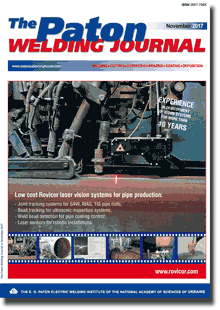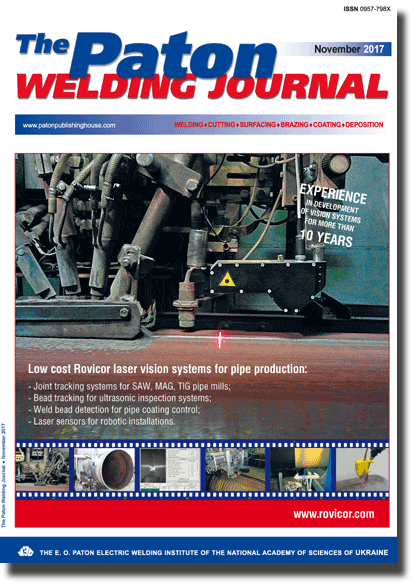| 2017 №11 (05) |
DOI of Article 10.15407/tpwj2017.11.01 |
2017 №11 (02) |

The Paton Welding Journal, 2017, #11, 8-12 pages
Modern flux-cored wires for welding of low-alloy steels of increased and high strength
V.N. Shlepakov, A.S. Kotelchuk and Yu.A. Gavrilyuk
E.O. Paton Electric Welding Institute of the NAS of Ukraine 11 Kazimir Malevich Str., 03150, Kiev, Ukraine. E-mail: office@paton.kiev.ua
Abstract
The paper studies the peculiarities of application of flux-cored wires for welding of metal structures of low-alloy steels of increased and high strength. The ways have been proposed for solving the problems existing in this field. The flux-cored wires developed in the recent years at the E.O. Paton Electric Welding Institute for these purposes were described. The directions of increase of quality and efficiency of flux-cored wire welding using modern equipment have been presented. 15 Ref., 2 Tables, 7 Figures.
Keywords: electric arc welding, flux-cored wire, low-alloy high-strength steels, heat input, wire melting efficiency, automation and control of welding process
Received: 17.10.17
Published: 06.12.17
References
- Irving, B. (1995) The challenge of welding heat-treatable alloy steels. Welding J., 74(2), 43–48.
- Keehan, E., Karlsson, L., Andren, H.O., Bhadeshia, H.K.D.H. (2006) New development with C–Mn–Ni high-strength steel weld metals. Pt A. Microstructure. Ibid., 85(9), 200–210.
- Adonyi, Y. (2002) Welding process effects in hydrogen industrial cracking susceptibility of high-performance steels. Ibid., 61–65.
- What is the difference between heat input and arc energy? http://www.twi-global.com/technical-knowledge/faqs/material-faqs/faq-what-is-the-difference-between-heat-input-and-arc-energy/
- DSTU EN ISO 14175:2014: Welding consumables. Shielding gases for arc welding and cutting [in Ukrainian].
- DSTU EN ISO 544: 2015: Welding consumables. Technical delivery conditions for filler materials. Type of product, dimensions, tolerances and markings [in Ukrainian].
- DSTU ISO 14344:2015: Welding and allied processes. Fluxes and shielding gases for arc welding. Guidelines for delivery of consumables [in Ukrainian].
- DSTU EN ISO 17632:2015: Welding consumables. Tubular cored electrodes for gas shielded and no-gas shielded metal arc welding of non-alloy and fine grain steels. Classification [in Ukrainian].
- DSTU EN ISO 18276:2015: Welding consumables. Tubular cored electrodes for gas-shielded metal arc welding of high strength steels. Classification [in Ukrainian].
- ANSI/AWS A4.3-93 (R2006): An American National Standard. Standard methods for determination of the diffusible hydrogen content of martensitic, bainitic, and ferritic steel weld metal produced by arc welding.
- Rama, R.S. (2006) Principles of power electronics. Moscow, Tekhnosfera [in Russian].
- Maleshin, V.I. (2005) Transistor conversion technique. Moscow, Tekhnosfera [in Russian].
- Mironov, S. (2003) Inverter power sources for arc welding. Svarochn. Proizvodstvo, 4, 41-43.
- (2007) Trans sinergic MIG/MAG power source 4000/5000/2700. Operating instructions. List of spare parts. Wels, Fronius Intern. GmbH.
- Designed and put into operation assembly-welding stand of side wall frameworks of freight cars. http://uptm.com.ua/index
Suggested Citation
V.N. Shlepakov, A.S. Kotelchuk and Yu.A. Gavrilyuk (2017) Modern flux-cored wires for welding of low-alloy steels of increased and high strength. The Paton Welding J., 11, 8-12.The cost of subscription/purchase order journals or individual articles
| Journal/Currency | Annual Set | 1 issue printed |
1 issue |
one article |
| TPWJ/USD | 384 $ | 32 $ | 26 $ | 13 $ |
| TPWJ/EUR | 348 € | 29 € | 24 € | 12 € |
| TPWJ/UAH | 7200 UAH | 600 UAH | 600 UAH | 280 UAH |
| AS/UAH | 1800 UAH | 300 UAH | 300 UAH | 150 UAH |
| AS/USD | 192 $ | 32 $ | 26 $ | 13 $ |
| AS/EUR | 180 € | 30 € | 25 € | 12 € |
| SEM/UAH | 1200 UAH | 300 UAH | 300 UAH | 150 UAH |
| SEM/USD | 128 $ | 32 $ | 26 $ | 13 $ |
| SEM/EUR | 120 € | 30 € | 25 € | 12 € |
| TDNK/UAH | 1200 UAH | 300 UAH | 300 UAH | 150 UAH |
| TDNK/USD | 128 $ | 32 $ | 26 $ | 13 $ |
| TDNK/EUR | 120 € | 30 € | 25 € | 15 € |
AS = «Automatic Welding» - 6 issues per year;
TPWJ = «PATON WELDING JOURNAL» - 12 issues per year;
SEM = «Electrometallurgy Today» - 4 issues per year;
TDNK = «Technical Diagnostics and Non-Destructive Testing» - 4 issues per year.


